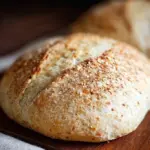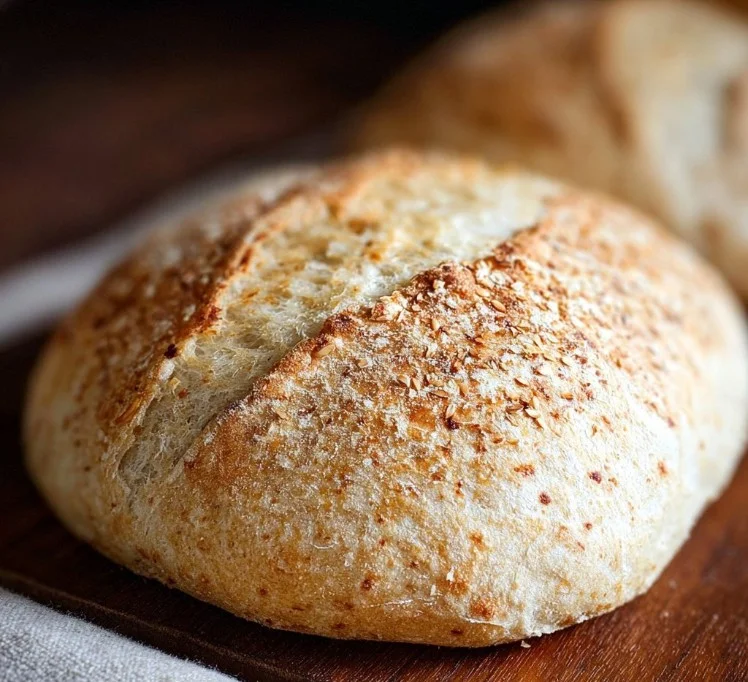Peasant bread is a timeless staple that brings the warm, comforting scent of fresh bread into your home. This rustic loaf embodies simplicity and tradition, making it a perfect addition to any meal. With just a handful of ingredients, you can create a delicious bread that not only fills your kitchen with delightful aromas but also nourishes the soul.
Why We Love This Peasant Bread Recipe
There’s something undeniably appealing about peasant bread. Perhaps it’s the straightforward process that allows even the most novice bakers to achieve excellent results, or maybe it’s the satisfying crust that encases a soft and chewy interior. What truly sets peasant bread apart is the way it evokes memories of family gatherings, hearty meals, and cozy moments spent at the table. This bread is perfect for everyday use, yet it’s special enough to serve at gatherings, making it a versatile companion to various dishes.
Ingredients about Peasant Bread
To craft your own delicious peasant bread, gather the following ingredients, ensuring each measurement is precise for the best results:
- 1 package dry yeast
- 2 1/4 teaspoons active dry yeast
- 2 cups warm water (about 110 degrees Fahrenheit)
- 1 tablespoon sugar
- 2 teaspoons salt
- 4 cups all-purpose flour
- 1 egg white or melted butter (for topping)
- Garlic salt (to taste)
These simple ingredients come together to create a bread that is not only hearty and delicious but also incredibly easy to make.
How to Make Peasant Bread Directions
Making peasant bread is straightforward and doesn’t require advanced baking skills. Begin by activating the yeast. In a small bowl, combine the yeast with warm water and let it sit for about 10 minutes. This step ensures that the yeast becomes frothy and active, which is essential for a good rise.
Once the yeast has bubbled up, transfer this mixture to a larger mixing bowl. Add the sugar, salt, and flour to the bowl with the activated yeast. Mix the ingredients gently, being careful not to overwork the dough. Unlike other bread recipes that require kneading, peasant bread benefits from a more hands-off approach. Just combine the ingredients until they are well blended.
After mixing, cover the bowl with a kitchen towel and place it in a warm, draft-free area. Let the dough rise until it has doubled in size, usually about an hour. You’ll know it’s ready when it looks puffy and full of air bubbles.
Once the dough has risen, divide it into two equal portions. Shape each portion into a round loaf and place them on a greased cookie sheet. Allow the rounds to rise again until they double in size, another 30-60 minutes.
While your loaves are rising, preheat your oven to 425°F (220°C). Just before baking, brush the tops of the bread rounds with either an egg white or melted butter. This step adds a beautiful sheen to the crust. Don’t forget to sprinkle garlic salt on top for an extra burst of flavor.
Bake the bread at 425°F for 10 minutes, then lower the temperature to 375°F (190°C) and continue baking for approximately 15 minutes. Keep an eye on the color; the bread should turn a lovely golden brown. Once it is done, remove it from the oven and let it cool on a wire rack.
How to Serve Peasant Bread
Peasant bread is incredibly versatile and can be served in various ways. Slice it while still warm and slather it with butter for a simple yet indulgent treat. It pairs beautifully with soups, stews, or salads, adding a homemade touch to your meals.
You can also toast slices of peasant bread to create delicious bruschetta by topping them with tomatoes, herbs, and a drizzle of olive oil. The hearty texture of the bread holds up well to various toppings, making it a great choice for appetizers.
Another delightful way to enjoy this bread is to use it as a base for sandwiches. Layer your favorite ingredients between slices of peasant bread for a satisfying lunch. No matter how you serve it, you’re bound to enjoy the warm, comforting flavors that come from this rustic loaf.
Expert Tips: Peasant Bread
To ensure your peasant bread comes out perfectly every time, consider these expert tips:
- Water Temperature: Make sure your water is warm but not hot; around 110°F is ideal. Too hot can kill the yeast, while too cool may not activate it properly.
- Measure Flour Accurately: Avoid packing the flour into the measuring cup. Instead, spoon the flour into the cup and level it off with a knife for accurate measurement.
- Patience with Rising: Don’t rush the rising process. If your kitchen is cool, it may take longer for the dough to double in size. Allow enough time for it to rise properly, as this ensures a light and airy bread.
- Experiment with Flavors: While garlic salt adds a nice touch, feel free to experiment with different toppings or mix-ins. Herbs, cheese, or seeds can elevate the flavor profile.
- Use a Pizza Stone: If you have one, baking your peasant bread on a preheated pizza stone can enhance the crust’s texture, giving you a more rustic result.
By following these tips, you can become a master of peasant bread baking, delighting your family and friends with your homemade creations.
How to Store Peasant Bread
Storing your peasant bread properly will help maintain its freshness and texture. Once the bread has completely cooled, you can store it in a few different ways.
For short-term storage, place the bread in a paper bag or wrap it in a clean kitchen towel. This method helps retain moisture while allowing some air to circulate, preventing condensation that can lead to mold.
If you want to store the bread for an extended period, consider freezing it. Wrap the bread tightly in plastic wrap, then place it in a freezer-safe bag. When you’re ready to enjoy it again, follow these easy steps: let the bread thaw at room temperature, then reheat it in the oven for a few minutes to restore its crustiness.
Regardless of how you store it, fresh peasant bread can be enjoyed for several days, though it’s best when consumed within the first few days of baking.
Variation of Peasant Bread
While the classic peasant bread recipe is delightful on its own, there are numerous variations you can try to suit your taste preferences. For example, incorporating different flours, such as whole wheat or rye, can add depth to the flavor and nutritional value.
Adding seeds like sunflower or pumpkin can give you an added crunch and nutrition. You can also experiment with herbs; adding rosemary or thyme can create a savory version that can be enjoyed on its own.
Another popular variation involves incorporating cheese. Feta or mozzarella adds a delicious element that pairs wonderfully with the rustic texture of the bread. Simply fold the cheese into the dough before the first rise for a delightful cheesy experience.
You might also consider turning your peasant bread into a flavored loaf by adding roasted garlic, sun-dried tomatoes, or olives. These ingredients lend a Mediterranean flair that is incredibly appetizing.
The beauty of peasant bread lies in its versatility. Feel free to experiment with your own combinations to create a loaf that reflects your tastes.
FAQ
What makes peasant bread different from other types of bread?
Peasant bread differs from other breads primarily in its simplicity and traditional roots. It uses fewer ingredients, often relies on basic pantry staples, and doesn’t require complex techniques, making it accessible to everyone.
Can I make peasant bread without yeast?
While yeast is critical for the rise and texture of peasant bread, you can experiment with sourdough starters or baking powder as alternatives. However, results may vary in flavor and texture.
How long does it take to make peasant bread?
From start to finish, making peasant bread can take about 2 to 3 hours, including rising times. However, once you get the hang of it, you’ll find that it’s a simple and rewarding process.
Can I use bread flour instead of all-purpose flour?
Yes, you can use bread flour instead of all-purpose flour. Bread flour has a higher protein content, which can contribute to a chewier texture. Just remember to adjust your water slightly, as bread flour tends to absorb more moisture.
What should I do if my dough doesn’t rise?
If your dough does not rise, it’s likely that the yeast was inactive. Make sure your yeast is fresh and that your water temperature did not kill it. Warm environments are best for rising; consider moving it to a warmer area or extending the rise time.

Peasant Bread
Ingredients
Bread Ingredients
- 1 package dry yeast Use active dry yeast.
- 2.25 teaspoons active dry yeast Ensure it is fresh.
- 2 cups warm water Around 110°F (43°C).
- 1 tablespoon sugar Helps activate the yeast.
- 2 teaspoons salt For flavor.
- 4 cups all-purpose flour Measure accurately.
- 1 whole egg white or melted butter For topping.
- to taste garlic salt Optional seasoning.
Instructions
Preparation
- In a small bowl, combine the yeast with warm water and let it sit for about 10 minutes until frothy.
- Transfer the yeast mixture to a larger bowl. Add sugar, salt, and flour. Mix gently until well blended.
- Cover the bowl with a kitchen towel and let the dough rise in a warm, draft-free area until doubled in size (about 1 hour).
- Divide the risen dough into two equal portions and shape each into a round loaf. Place on a greased cookie sheet.
- Allow the shaped loaves to rise until doubled in size again (30-60 minutes).
Baking
- Preheat your oven to 425°F (220°C).
- Brush the tops of the loaves with egg white or melted butter and sprinkle with garlic salt.
- Bake at 425°F for 10 minutes, then reduce the temperature to 375°F (190°C) and continue baking for 15 minutes until golden brown.
- Remove from the oven and cool on a wire rack.
Send me this recipe!
Just enter your email below and get it sent straight to your inbox!



